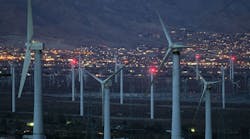According to two reports recently released by the U.S. Energy Department, the U.S. wind-energy industry continued growing at an impressive rate in 2014. With rapidly increasing wind-energy generation, fast-growing demand, and steadily decreasing wind-energy prices—the lowest ever seen in the United States—the U.S. wind-energy market remains strong.
“With declining costs and continued technological development, these reports demonstrate that wind power is a reliable source of clean, renewable energy for American homes and businesses,” Energy Secretary Ernest Moniz said. “Through continued investments and the help of stable policies, we’re confident that wind power will keep playing a major role in creating jobs and shaping America’s clean-energy future.”
Wind Technologies Market Report
According to "2014 Wind Technologies Market Report," released by the Energy Department and its Lawrence Berkeley National Laboratory, total installed wind-power capacity in the United States grew at a rate of 8 percent in 2014 and now stands at nearly 66 gigawatts, which ranks second in the world and meets 4.9 percent of end-use electricity demand in an average year. The United States was the global leader in total wind-energy production in 2014. The report also finds that wind-energy prices are at an all-time low and are competitive with wholesale power prices and traditional power sources across many areas of the United States.
The report shows utility-scale turbines with larger rotors designed for lower wind speeds increasingly were deployed across the country in 2014. The findings also suggest the success of the U.S. wind industry has had a ripple effect on the American economy, supporting 73,000 jobs related to development, siting, manufacturing, transportation, and other industries, an increase of 22,500 jobs from 2013 to 2014.
Distributed Wind Market Report
U.S. turbines in distributed applications reached a cumulative installed capacity of more than 906 megawatts—enough to power more than 168,000 average American homes—according to "2014 Distributed Wind Market Report," released by the Energy Department and its Pacific Northwest National Laboratory. This capacity came from roughly 74,000 turbines installed across all 50 states, Puerto Rico, and the U.S. Virgin Islands. Compared with traditional centralized power plants, distributed wind-energy installations supply power directly to the local grid near homes, farms, businesses, and communities. Turbines used in these applications can range in size from a few hundred watts to multimegawatts and help power remote, off-grid homes and farms, as well as local schools and manufacturing facilities.
As shown in the report, America's distributed wind-energy industry supports a growing domestic industrial base. U.S.-based small-wind-turbine manufacturers claimed another strong year of exports to countries across the globe, accounting for nearly 80 percent of U.S.-based manufacturers’ sales.










